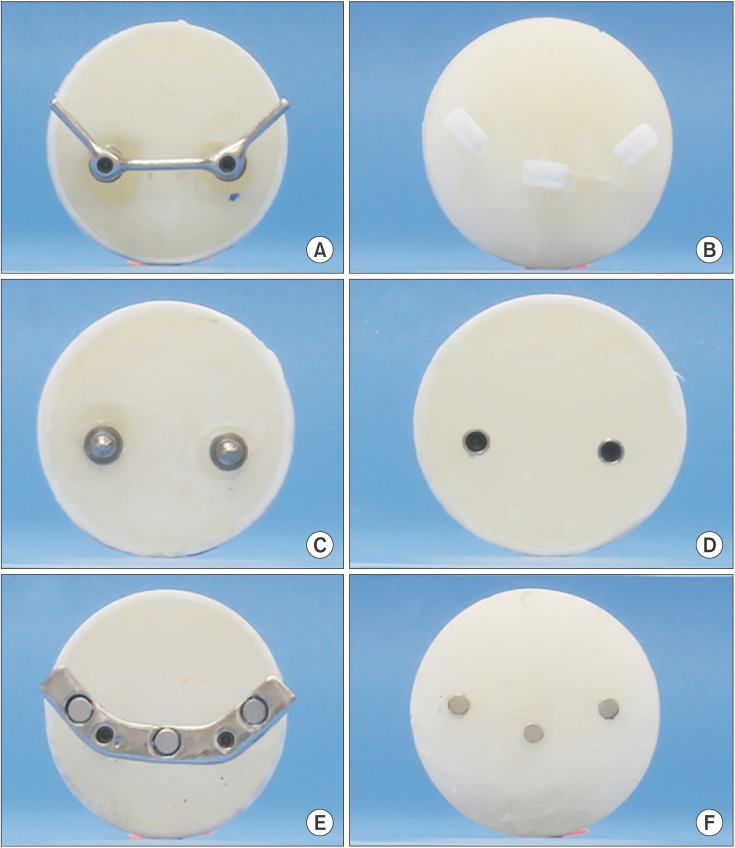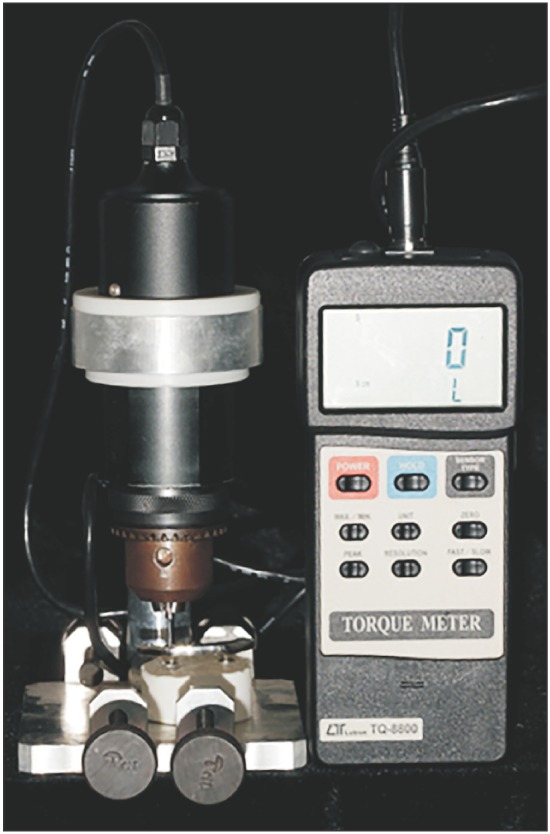J Korean Assoc Oral Maxillofac Surg.
2016 Dec;42(6):352-357. 10.5125/jkaoms.2016.42.6.352.
Stability of the prosthetic screws of three types of craniofacial prostheses retention systems
- Affiliations
-
- 1Division of Oral and Maxillofacial Surgery, Department of Oral Diagnosis, Piracicaba Dental School, University of Campinas, Piracicaba, Brazil. edersiguaodont@gmail.com
- 2Department of Oral and Maxillofacial Surgery, Universidad de La Frontera, Temuco, Chile.
- 3Center for Biomedical Research, Universidad Autónoma de Chile, Temuco, Chile.
- KMID: 2364002
- DOI: http://doi.org/10.5125/jkaoms.2016.42.6.352
Abstract
OBJECTIVES
This study aimed to evaluate the stability of prosthetic screws from three types of craniofacial prostheses retention systems (bar-clip, ball/O-ring, and magnet) when submitted to mechanical cycling.
MATERIALS AND METHODS
Twelve models of acrylic resin were used with implants placed 20 mm from each other and separated into three groups: (1) bar-clip (Sistema INP, São Paulo, Brazil), (2) ball/O-ring (Sistema INP), and (3) magnet (Metalmag, São Paulo, Brazil), with four samples in each group. Each sample underwent a mechanical cycling removal and insertion test (f=0.5 Hz) to determine the torque and the detorque values of the retention screws. A servo-hydraulic MTS machine (810-Flextest 40; MTS Systems, Eden Prairie, MN, USA) was used to perform the cycling with 2.5 mm and a displacement of 10 mm/s. The screws of the retention systems received an initial torque of 30 Ncm and the torque values required for loosening the screw values were obtained in three cycles (1,080, 2,160, and 3,240). The screws were retorqued to 30 Ncm before each new cycle.
RESULTS
The sample was composed of 24 screws grouped as follows: bar-clip (n=8), ball/O-ring (n=8), and magnet (n=8). There were significant differences between the groups, with greater detorque values observed in the ball/O-ring group when compared to the bar-clip and magnet groups for the first cycle. However, the detorque value was greater in the bar-clip group for the second cycle.
CONCLUSION
The results of this study indicate that all prosthetic screws will loosen slightly after an initial tightening torque, also the bar-clip retention system demonstrated greater loosening of the screws when compared with ball/O-ring and magnet retention systems.
MeSH Terms
Figure
Reference
-
1. Bacchi A, Regalin A, Bhering CL, Alessandretti R, Spazzin AO. Loosening torque of Universal Abutment screws after cyclic loading: influence of tightening technique and screw coating. J Adv Prosthodont. 2015; 7:375–379. PMID: 26576253.
Article2. Jemt T, Lekholm U, Gröndahl K. 3-year followup study of early single implant restorations ad modum Brånemark. Int J Periodontics Restorative Dent. 1990; 10:340–349. PMID: 2098358.3. Binon PP. Evaluation of the effectiveness of a technique to prevent screw loosening. J Prosthet Dent. 1998; 79:430–432. PMID: 9576318.
Article4. Cibirka RM, Nelson SK, Lang BR, Rueggeberg FA. Examination of the implant-abutment interface after fatigue testing. J Prosthet Dent. 2001; 85:268–275. PMID: 11264934.
Article5. Karakoca S, Aydin C, Yilmaz H, Bal BT. Retrospective study of treatment outcomes with implant-retained extraoral prostheses: survival rates and prosthetic complications. J Prosthet Dent. 2010; 103:118–126. PMID: 20141816.
Article6. Visser A, Raghoebar GM, van Oort RP, Vissink A. Fate of implant-retained craniofacial prostheses: life span and aftercare. Int J Oral Maxillofac Implants. 2008; 23:89–98. PMID: 18416416.7. Sencimen M, Bal HE, Demiroğullari M, Kocaoglu M, Dogan N. Auricular episthesis retained by an attachment system (2 case reports). Oral Surg Oral Med Oral Pathol Oral Radiol Endod. 2008; 105:e28–e34.
Article8. Hooper SM, Westcott T, Evans PL, Bocca AP, Jagger DC. Implant-supported facial prostheses provided by a maxillofacial unit in a U.K. regional hospital: longevity and patient opinions. J Prosthodont. 2005; 14:32–38. PMID: 15733133.
Article9. Aydin C, Karakoca S, Yilmaz H, Yilmaz C. Implant-retained auricular prostheses: an assessment of implant success and prosthetic complications. Int J Prosthodont. 2008; 21:241–244. PMID: 18548964.10. Weiss EI, Kozak D, Gross MD. Effect of repeated closures on opening torque values in seven abutment-implant systems. J Prosthet Dent. 2000; 84:194–199. PMID: 10946337.
Article11. Cardoso M, Torres MF, Lourenço EJ, de Moraes Telles D, Rodrigues RC, Ribeiro RF. Torque removal evaluation of prosthetic screws after tightening and loosening cycles: an in vitro study. Clin Oral Implants Res. 2012; 23:475–480. PMID: 21457352.
Article12. Fromentin O, Picard B, Tavernier B. In vitro study of the retention and mechanical fatigue behavior of four implant overdenture stud-type attachments. Pract Periodontics Aesthet Dent. 1999; 11:391–397. quiz 398. PMID: 10379298.13. Wichmann MG, Kuntze W. Wear behavior of precision attachments. Int J Prosthodont. 1999; 12:409–414. PMID: 10709521.14. Cho WR, Huh YH, Park CJ, Cho LR. Effect of cyclic loading and retightening on reverse torque value in external and internal implants. J Adv Prosthodont. 2015; 7:288–293. PMID: 26330975.
Article15. de Sousa AA, Mattos BS. Magnetic retention and bar-clip attachment for implant-retained auricular prostheses: a comparative analysis. Int J Prosthodont. 2008; 21:233–236. PMID: 18548962.16. Moura e Costa AJ, Lasserre FS, Westphalen VP, Deonizio MD, da Silva Neto UX, de Sousa MH. Delayed tooth replantation: case report. Rev Clin Pesq Odontol. 2004; 1:41–43.17. Patterson EA, Johns RB. Theoretical analysis of the fatigue life of fixture screws in osseointegrated dental implants. Int J Oral Maxillofac Implants. 1992; 7:26–33. PMID: 1398820.18. Siamos G, Winkler S, Boberick KG. Relationship between implant preload and screw loosening on implant-supported prostheses. J Oral Implantol. 2002; 28:67–73. PMID: 12498448.
- Full Text Links
- Actions
-
Cited
- CITED
-
- Close
- Share
- Similar articles
-
- Epitec system: an indirect osseointegration for the ear prosthesis anchorage
- Three-dimensional finite element analysis of stress distribution and preload of different connection types implant with initial clamping
- Attitude and treatment options in implant-supported prosthetics: A survey among a cohort of German dentists
- Implant-Supported Fixed Dental Prostheses with New Retention Type Using Zirconia Ball and Nickel-Titanium Spring
- Treatment of the cleft lip and palate patient with few remaining posterior teeth using hybrid telescopic crown denture



